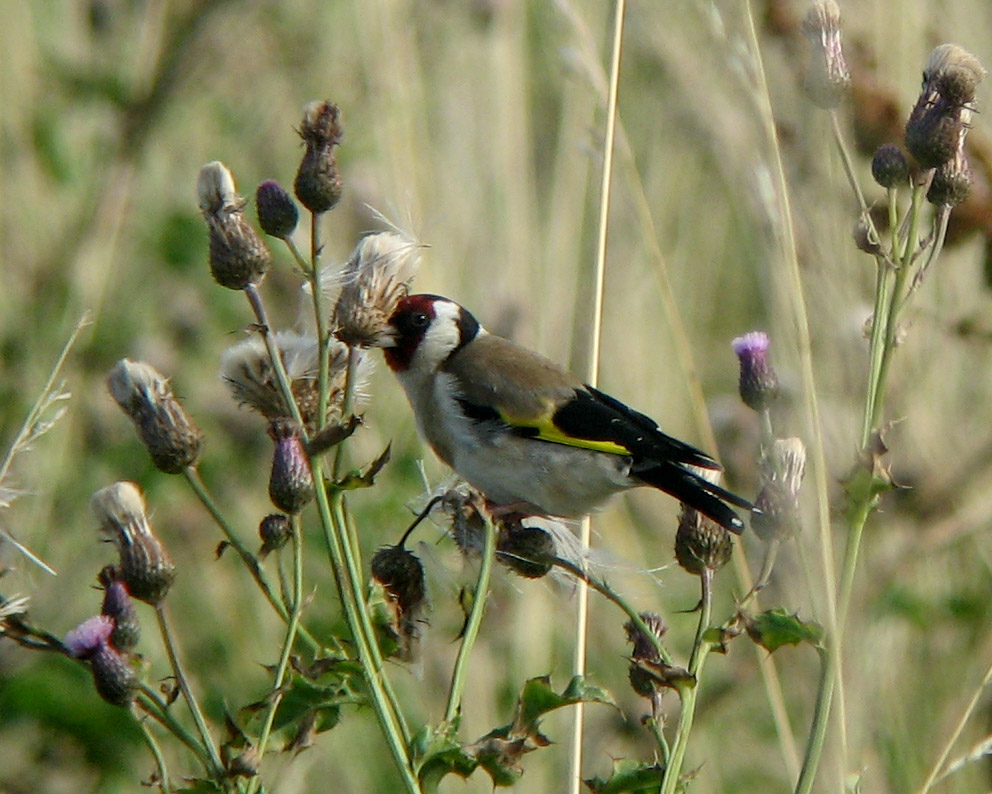photo creditBy photo MPF (Own work) [GFDL (http://www.gnu.org/copyleft/fdl.html) or CC-BY-SA-3.0 (http://creativecommons.org/licenses/by-sa/3.0/)], via Wikimedia Commons“A weed is but an unloved flower.” ~ Ella Wheeler Wilcox
Canada Thistle is a hated weed that has naturalized to America from Europe. Despite this unwanted status, thistle plays many ecological roles such as breaking up hardpan soil in areas of heavy clay and providing nectar to bees, butterflies, beneficial insects, as well as seeds for birds. I have noticed that this plant protects growing trees from browsing animals and provides cover for birds and other animals. The thistle is a member of the artichoke family and its flower head can provide a small edible nubbin. The flower head have been collected to curdle milk. According to Plants for a Future, the flowers, leaves, oil, roots, stems and seeds are all edible. The stem has a fiber which can be made into paper. The milk thistle, whose seeds contain 4 to 6 percent silymarin, has been cultivated for the pharmaceutical industry on a larger scale in Austria, Germany, Hungry, Poland, China and Argentina. Silymarin has been used in the treatment of Type 2 diabetes with significant results. Also, silymarin is being investigated as an anti-liver cancer agent in people at risk for this condition such as those with liver cirrhosis. Canada thistle generally grows on soil that is compacted…so much so that it so considered an indicator plant for that condition. Its roots are able to penetrate up to 20 feet deep, causing it to "mine” nutrients and moisture, bring them to the surface to share with other plants. . It is a valuable plant for bees. In addition to attracting long-tongued bees and short-tongued bees, the flowers of Canada Thistle attract a wide variety of beneficial insects such as ladybugs and predatory insects. The caterpillars of the butterfly Vanessa cardui (Painted Lady) feed on the foliage of thistles, as do the caterpillars of many moth species. The seeds of Canada Thistle and other thistles are a source of food for songbirds, including the Eastern Goldfinch, Pine Siskin, Slate-Colored Junco, Indigo Bunting, and Clay-Colored Sparrow. Because of the thorny foliage, mammalian herbivores usually avoid eating this plant, except when little else is available. However, there is an author and educator called Kathy Voth who has been teaching cows to eat weeds including thistle. She has written the book called "Cows Eat Weeds" Scotland has made the thistle their national flower emblem and has songs dedicated to this plant. There is a legend that the thistle saved them from a Norse invasion when a barefoot Norseman, trying to surprise the Scots army in an attempt to silently attack, stepped on a thistle, letting out a cry, alerting the Scots army to their approach. This plant has been very difficult to manage in agricultural fields and is intensely disliked by most farmers. As with most unwanted plants, there is a complex set of reasons why this plant is able to establish itself and cause so many problems. It is a plant that will not compete well in densely vegetated, porous healthy soil. Thistle easily establishes itself on bare land, on compacted soils where many other plants are unable to grow, on disturbed soils and on overgrazed pastures. Organic methods to suppress thistle growth involve using cover crops of clover or alfalfa combined with mowing. In Estonia, there is a study presented at the 10th International Soil Conservation Organization Meeting held in 1999 at Purdue University, where Canada thistle was used with success to rehabilitate soil compacted by tractor use. The thistle families are incredible and valuable plants, with many uses for us and with benefits for many of our insects, birds and animals. But because of our land use practices, it is difficult to control its spread. We do need to prevent this plant from invading our lands, but more importantly we need to adopt agricultural practices and land use practices that discourage this plant from being able to establish itself. We are all interconnected and we can learn how to control this plant safely and wisely, not with poisons but by improving our soil and managing our land with knowledge. https://en.wikipedia.org/wiki/Cirsium_arvense http://www.pfaf.org/user/Plant.aspx?LatinName=Cirsium+arvense http://topsoil.nserl.purdue.edu/nserlweb-old/isco99/pdf/ISCOdisc/SustainingTheGlobalFarm/P090-Kuht.pdf https://www.cog.ca/documents/WeedsMessengerSU06.pdf http://www.oacc.info/NewspaperArticles/na_community_ts.asp http://traditionalcatholichomestead.com/2015/05/29/organic-control-for-canadian-thistle/
1 Comment
Jinny Thompson
7/17/2022 06:10:21 am
We cleared a 2-acre field of dead ash trees, and now we have 2 acres of Canadian thistle. We have 55 acres of hay, so we are planning to leave this area for wildflowers, etc. We don't believe in using poisons. What would you advise?
Reply
Leave a Reply. |
CategoriesAuthorManitoba is where I was born and where I have spent most of the five and one half decades of my life. I lived on the outskirts of the town of Portage La Prairie at a time when tadpoles and frogs inhabited the ditches and ponds, when there were many Monarch butterflies each summer along with dragon flies and grasshoppers. Redwing blackbirds perched the cattails of the ditches. As children we picked dandelions for bouquets and made wishes before blowing dandelion seed heads. We searched clover for lucky four leaves and rolled on the grass…there was no concern of poisonous herbicides. The grass was thick. Wherever we dug…there were earthworms Archives
September 2015
|
Photo used under Creative Commons from wackybadger


 RSS Feed
RSS Feed
